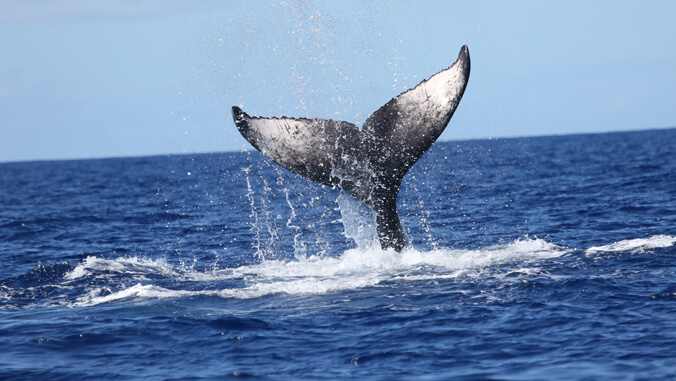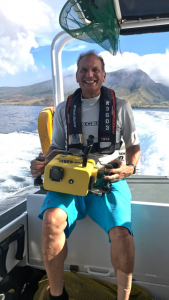
More than 10,000 images of humpback whale tail flukes collected by University of Hawaiʻi researchers have played a pivotal role in revealing both positive and negative impacts on North Pacific humpback whales, positive trends in the historical annual abundance of North Pacific humpback whales, and how a major climate event negatively impacted the population. Adam Pack, who heads the UH Hilo Marine Mammal Laboratory, Lars Bejder, director of the UH Mānoa Marine Mammal Research Program (MMRP) and graduate students Martin van Aswegen and Jens Currie, co-authored a study on humpback whales in the North Pacific Ocean, and the images—along with artificial intelligence (AI)-driven image recognition—were instrumental in tracking individuals and offering insights into their 20% population decline observed in 2012–21.

“The underside of a humpback whale’s tail fluke has a unique pigmentation pattern and trailing edge that can serve as the ‘finger-print’ for identifying individuals,” said Pack.
Starting in 1976, Pack’s mentor the late Louis M. Herman, founder and director of the UH Mānoa Kewalo Basin Marine Mammal Laboratory (KBMML), initiated collecting tail fluke images of humpback whales in Hawaiian waters alongside his students. The effort expanded to humpback whales in Alaska in 1980 and has continued every year since through the KBMML, the non-profit organization The Dolphin Institute which Herman and Pack founded in 1993, and in 2008 and beyond through Pack’s UH Hilo Marine Mammal Lab. In total, more than 30,000 whale tail images have been accumulated in waters off Hawaiʻi and Alaska resulting in one of the largest archival catalogs of humpback whales in the world. UH Hilo students are tasked with cataloging those images.
“Until recently, comparing photographs of humpback whales to each other to discover resightings of the same individual and develop individual histories over decades was done by eye, a slow and labor intensive effort,” Pack said.
The recent advent of AI image-recognition tools has revolutionized the process facilitating large-scale collaborations involving decades of data.
AI and humpback whale science
The UH team of researchers are part of the 76 co-authors who contributed to the findings recently published in Royal Society Open Science which showcases the impact of artificial intelligence in the groundbreaking study. AI-driven image recognition was used to organize the tail fluke images of both the UH Hilo Marine Mammal Laboratory and the UH Mānoa Marine Mammal Research Program, along with thousands of other submissions from across the North Pacific, into an online humpback whale fluke matching program and database. The cutting-edge approach was led by Ted Cheeseman, the study’s lead author and the developer of research website Happy Whale.
“It shows how when we all pool our resources and talent together, we can learn remarkable things about humpback whales and their marine environment,” said Pack, who holds a joint appointment in the departments of psychology and biology at UH Hilo.
A closer look at population increase and decline
The study showed a strong continuing recovery of North Pacific humpback whales from 20th century commercial whaling which ended in 1976 decimating the population to an estimated 1500–2000 whales. The study estimated 16,875 whales in 2002 growing to a peak of 33,488 in 2012. However, researchers also uncovered a critical period from 2014 to 2016 when an unprecedented marine heatwave adversely impacted marine resources including those in high latitudes which humpback whales rely on for sustenance. This decline in resources resulted in several years of poor reproductive and physical health for many humpbacks wintering in Hawaiʻi and summering in Alaska.
The population decline was especially noticeable in Hawaiʻi, a vital destination for thousands of humpback whales seeking warmer waters to mate, give birth, and raise their young. By 2021, the study found a staggering 34% decrease in the humpback whale population in these waters. It indicates that continued monitoring of North Pacific humpback whales and care for their marine habitats is essential.
For more go to UH Hilo Stories.

